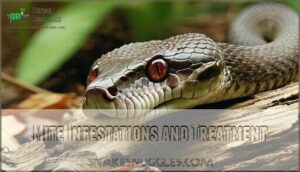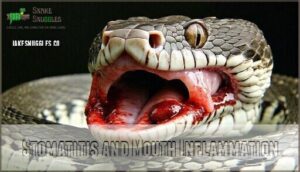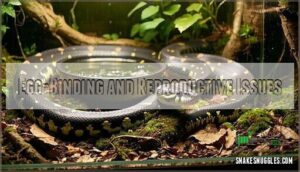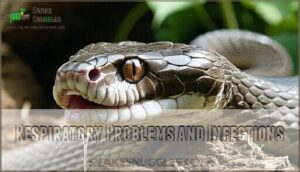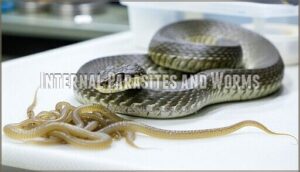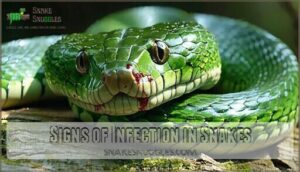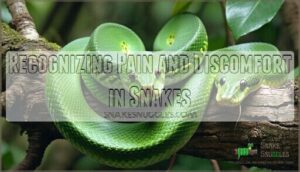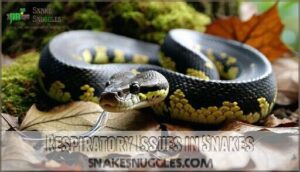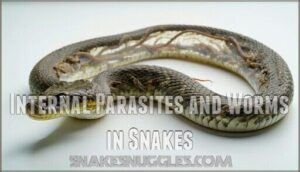This site is supported by our readers. We may earn a commission, at no cost to you, if you purchase through links.

Look for changes in appetite, weight, or behavior, as these can indicate underlying health issues.
Respiratory problems, skin abnormalities, and parasites are common concerns.
If you notice any unusual symptoms, it is vital that you investigate further.
Recognizing these signs early on can make a big difference in your snake’s health, and there’s more to learn about keeping your pet snake thriving and healthy with great care.
Table Of Contents
- Key Takeaways
- General Signs of Illness in Snakes
- Skin Problems in Snakes
- Common Snake Diseases and Conditions
- Signs of Infection in Snakes
- Snake Mite Infestations and Control
- Recognizing Pain and Discomfort in Snakes
- Snake Vomiting and Regurgitation
- Respiratory Issues in Snakes
- Internal Parasites and Worms in Snakes
- When to Seek Veterinary Care for Your Snake
- Frequently Asked Questions (FAQs)
- How can I tell if my snake is sick?
- What are some specific symptoms of common illnesses in snakes?
- Why is shedding a concern for snake health?
- What are some signs of respiratory problems in snakes?
- What are some behavioral changes that may indicate snake illness?
- When should I seek veterinary care for my snake?
- What are signs of discomfort in snakes?
- What does an unhealthy snake look like?
- How can you tell if a snake is bad?
- How to tell if ball python is unhealthy?
- Conclusion
Key Takeaways
- Look out for changes in your snake’s appetite, energy, or hiding habits—these shifts often show your pet’s not feeling well.
- Watch for physical symptoms like lethargy, sunken eyes, patchy shedding, unusual discharge, or skin lesions, and act quickly if you spot them.
- Don’t ignore breathing problems such as wheezing or open-mouth breathing, as respiratory issues can turn serious fast.
- If you’re unsure about your snake’s behavior or health, don’t wait—reach out to a reptile-savvy vet right away.
General Signs of Illness in Snakes
Knowing when your snake needs medical attention can save its life, as these reptiles often hide illness until it becomes severe.
Act fast, snake health issues can escalate quickly
Early recognition of warning signs allows you to take action before minor health issues become life-threatening emergencies.
Changes in Behavior and Appetite
Three critical behavioral changes signal your snake’s declining health. Watch for these warning signs:
- Lethargy signs – Your snake becomes unusually inactive and sluggish
- Hiding increase – Extended periods tucked away beyond normal behavior
- Appetite loss – Refusing favorite foods or showing no feeding interest
Snake behavior changes like appetite changes and snake refusal eat often appear before physical symptoms. Weight fluctuations follow when your snake won’t eat consistently.
Snake abnormal behavior including snake lethargy and regurgitation issues require immediate attention.
Physical Symptoms and Appearance
When examining your snake, several physical symptoms can signal serious health problems.
Visual changes often appear before behavioral ones, making careful observation essential.
Watch for these critical warning signs:
- Scale abnormalities – soft, discolored patches indicating snake scale rot
- Eye cloudiness or sunken appearance suggesting dehydration or infection
- Abnormal discharge from mouth, nose, or eyes signaling respiratory issues
- Body limpness when handling instead of normal muscle tone
- Skin discoloration including pink undersides indicating sepsis
These sick snake symptoms require immediate attention.
A key indicator is unusual lethargy, which can indicate a serious underlying issue.
Snake skin problems and snake eye problems often worsen rapidly without treatment.
Snake breathing difficulty may accompany these visual changes, creating emergency situations that demand veterinary care.
Common Health Issues in Snakes
Snake owners frequently encounter bacterial infections, fungal diseases, and metabolic disorders that can threaten their pet’s life.
You’ll notice sick snake symptoms like respiratory distress, skin lesions, or digestive issues. Nutritional deficiencies cause bone problems, while trauma injuries create open wounds.
Watch for reptile illness signs requiring immediate snake veterinary care.
Common Health Issues Symptoms
Skin Problems in Snakes
Your snake’s skin tells a story about its health, and learning to read the signs can save its life.
When shedding goes wrong or infections take hold, what starts as a minor issue can quickly become life-threatening without proper attention.
Dysecdysis and Shedding Issues
When your snake’s shedding frequency gets thrown off track, it’s often a red flag for dysecdysis or improper shedding.
This shedding problem typically stems from inadequate humidity levels, nutritional deficiencies, or stress affecting your snake’s enclosure environment.
Watch for these warning signs of snake shedding issues:
- Patchy or incomplete shed cycles that leave dried skin clinging to your snake
- Dull, cloudy appearance that persists longer than the normal pre-shed period
- Retained pieces around the eyes, tail tip, or between scales
- Abnormal shedding frequency – too often or infrequently for your species
- Thick, sticky pieces that won’t come off naturally during the process
While genetic predisposition can play a role, most snake skin problems result from environmental factors you can control, which can lead to dysecdysis or other issues, and it is crucial to monitor for warning signs to ensure the health of your snake.
Retained Skin and Eye Caps
Spotting retained skin or stubborn eye caps—those pesky “hazes” over your snake’s eyes—means it’s time to step in. These snake shedding issues often stem from low Humidity Levels or dysecdysis.
Low humidity below 50% is a primary cause of this condition.
To help out, try:
- Soaking your snake in warm water as a gentle Shedding Aid
- Misting the enclosure regularly
- Seeking Veterinary Assistance if Preventing Caps becomes a struggle, especially for species predisposition to snake skin abnormalities
Mite Infestations and Treatment
If you ever notice tiny red or black dots—classic signs of snake mites—around your snake’s eyes or mouth, it’s time to act.
Mite Identification is key. Clean the enclosure thoroughly for Enclosure Sanitation, use parasite control products as Treatment Options, and consider Veterinary Intervention if needed.
Preventative Measures, like regular cleaning, help stop external parasites and future mite infection. Some mites, like dust mites, thrive in warm, humid environments.
Skin Infections and Lesions
Dealing with skin infections and lesions in snakes can feel like walking on eggshells. These snake skin conditions often start small but can quickly worsen.
Watch for:
- Scaly patches or blisters (Scale Rot or Blister Disease)
- Persistent wounds that don’t heal, possibly pointing to a snake bacterial infection
- Odd colors or peeling, suggesting a snake fungal infection
Quick Abscess Treatment and good Lesion Prevention are key to keeping your snake healthy.
Common Snake Diseases and Conditions
You’ll find that snakes can develop a range of common diseases, from mouth infections to breathing problems and parasites.
Knowing these conditions helps you spot trouble early and get your snake the care it needs.
Stomatitis and Mouth Inflammation
A healthy smile means more than just flashy fangs—it’s about good oral hygiene and avoiding mouth rot.
Infectious stomatitis, or snake mouth rot, sneaks in with red, swollen gums and feeding issues. You’ll see mucus, mouth infection, or even jaw swelling. Quick antibiotic treatment is key.
Pair preventative care with regular checks to stop mouth rot in its tracks.
| Symptom | Preventative Care |
|---|---|
| Swollen gums | Oral hygiene routine |
| Feeding issues | Clean habitat, vet |
The key to maintaining a healthy smile is to combine regular checks with good habits.
Egg-Binding and Reproductive Issues
After mouth issues, reproductive troubles can sneak up fast.
Egg-binding, or dystocia, is a real concern in snake reproduction.
If your female snake suddenly loses her appetite, shows a swollen abdomen, or becomes unusually sluggish, she could be struggling with egg retention.
Watch for these signs, since egg binding can lead to serious problems like prolapse risks or infection.
Quick action and post-laying care matter.
Here’s what to keep in mind:
- Dystocia causes
- Egg retention
- Prolapse risks
- Fertility signs
- Post-laying care
- Snake eggbinding emergencies
Respiratory Problems and Infections
Catching a snake respiratory infection early can make all the difference.
Watch for wheezing sounds, nasal discharge, open-mouth breathing, or mucus bubbles—these signs mean your snake is struggling.
Respiratory disease often links back to poor humidity levels or a dirty enclosure.
Don’t wait; antibiotic treatment is usually needed.
If you spot these symptoms, call your reptile vet right away to address the respiratory disease.
Internal Parasites and Worms
A snake parasite infection can sneak up on you, showing up as weight loss, odd stools, or a sluggish pet.
Worm infestations—like nematodes or tapeworms—are common worm types.
Fecal exams help spot internal parasites early.
Deworming snakes with vet-prescribed parasite treatment is key.
Preventing parasites means quarantining newcomers and keeping the enclosure spotless.
One common issue is snake mite infestations.
Remember, some have a zoonotic risk, so wash your hands after handling snakes or cleaning, and always stay a step ahead to prevent parasite infections.
Signs of Infection in Snakes
You need to watch for signs of infection in your snake, as these can quickly become serious if left untreated.
Common symptoms include swelling, skin lesions, and unusual discharge, which all require prompt attention.
Sepsis and Blood Infections
When your pet’s scales turn pink or reddish underneath, it’s a red flag for septicemia—blood poisoning from snake bacterial infections.
Lethargy, tongue immobility, and loss of appetite often follow.
Sepsis spreads fast, so don’t wait, as quick action is the biggest factor in prognosis.
Snake blood tests confirm diagnosis, while antibiotic treatment and warm basking spots help recovery.
Abscesses and Pus-Filled Wounds
After learning about blood infections, it’s time to watch for abscesses—those swollen, pus-filled wounds that scream trouble.
Abscess causes range from bites to dirty enclosures, leading to bacterial infection and other snake health issues.
If you spot swelling or oozing, don’t wait. Prompt wound treatment, infection prevention, and antibiotic use are key.
Veterinary care is a must for snake infections or skin abnormalities—your snake’s life depends on it.
Fungal Infections and Skin Lesions
Abscesses aren’t the only skin trouble your snake might face.
Fungal infections often show up as red, swollen skin or crusty, blistered scales.
Watch for these five warning signs:
- Scales coming loose or thickened
- Blisters or fluid-filled bumps
- Cloudy eyes or swelling
- Lesions that spread
- Odd odors or sticky discharge
These infections can be caused by Ophidiomyces ophiodiicola fungus.
Identifying Fungi early, Treating Lesions, and controlling humidity prevent infections, which is crucial for maintaining your snake’s health and preventing the spread of fungal infections and lesions.
Snake Mite Infestations and Control
If you notice your snake scratching or soaking more than usual, it could be a sign of mites.
These tiny parasites can cause skin irritation, anemia, and serious health problems if not treated quickly.
Identifying Mites and Their Impact
Spotting mites early makes all the difference. These external parasites are small but mighty—think of them as tiny vampires hiding beneath your snake’s scales.
Mite Identification is key for Infestation Signs and Impact Assessment. You might see:
- Tiny black or red dots moving near the eyes, mouth, or jaw
- Specks floating in the water bowl
- Mites crawling between scales
- Loss of appetite or sluggish behavior
Unchecked mite infection can weaken your snake, so always watch for these clues.
Treating Mite Infestations and Prevention
Effective mite treatment combines chemical solutions with strict quarantine procedures.
Pyrethroid-based sprays eliminate adult mites, while topical treatments target all mite lifecycle stages.
Success requires isolating infected snakes and maintaining rigorous enclosure sanitation throughout treatment.
| Treatment Method | Application Details |
|---|---|
| Preventative sprays | Apply weekly during quarantine |
| Topical treatments | Veterinary-prescribed ivermectin |
| Water soaking | 15-20 minutes daily in warm water |
| Parasite control products | Predatory mites for biological control |
| Snake treatment protocols | Multiple applications over 3 weeks |
Cleaning and Disinfecting The Enclosure
Keeping up with snake enclosure hygiene isn’t just about sparkle—it’s life insurance for your snake.
Use safe disinfectants during every snake enclosure cleaning.
Don’t let water sanitation or substrate choices slide, and stick to a solid cleaning schedule to prevent buildup.
Proper snake enclosure setup and maintenance make all the difference in regards to snake sanitation:
- Swap dirty bedding quickly
- Scrub water bowls
- Wipe down surfaces
- Sanitize hides and décor.
To prevent infestations, consider using effective snake mite treatments, which can be a crucial part of snake enclosure hygiene and help ensure the overall health and well-being of your snake.
Recognizing Pain and Discomfort in Snakes
When your snake shows signs of pain or discomfort, it’s important to pay close attention to even the smallest changes.
Monitor your snake’s behavior and physical signs to catch potential health issues early and ensure their well-being
You’ll need to recognize unusual movements or behaviors, since these can help you spot health problems early.
Behavioral Changes and Body Language
Sometimes, you’ll spot trouble by watching for snake behavioral changes before you notice physical signs.
Behavior monitoring is key—lethargy signs, increased hiding, or appetite loss aren’t normal.
Watch for aggression changes, fewer tongue flicking moments, or your snake skipping its usual routines.
These snake behavior deviations could mean a problem, and early action helps you prevent more serious snake illness symptoms, which is why early action is crucial.
Physical Signs of Pain and Distress
When you notice changes in your snake’s behavior, it’s time to look for physical signs of pain and distress.
Pain isn’t always obvious, but these warning signs can help you spot trouble early:
- Sunken eyes
- Retained skin or stuck sheds
- Prominent vertebrae or visible spine
- Limpness or floppy muscles
- Abnormal postures
- Scale changes or odd patterns
- Muscle tremors
- Eyes remaining closed or hazy
Keep an eye out for increased hissing frequency, severe lethargy, snake behavior deviations, loss of appetite, and unusual postures, as these signs point to real discomfort and shouldn’t be ignored.
Providing a Comfortable Environment
Just like people, snakes need the right setup to feel at home.
To keep pain and discomfort at bay, focus on maintaining proper habitat conditions. Make sure your enclosure size fits your snake, and always use safe substrate choices like aspen or cypress mulch.
Provide a range of temperature gradients (75-85°F) and steady humidity levels (30-50%).
Hiding spots and enrichment, like rocks or tunnels, encourage natural behavior. When your snake’s environment suits its needs, you’re setting the stage for better health.
Snake Vomiting and Regurgitation
You’re checking your snake’s health and notice it’s vomiting or regurgitating its food, which can be a sign of a serious issue.
If you see this happening, it’s vital to identify the causes and symptoms of vomiting and regurgitation to provide the best care for your pet.
Causes and Symptoms of Vomiting
Regurgitation hits your snake’s digestive tract like a warning bell.
Several culprits trigger this messy problem:
- Digestive Blockages from improper prey size or substrate ingestion
- Temperature Issues disrupting normal snake feeding habits
- Stress Factors like handling after meals or habitat changes
- Parasitic Infections wreaking havoc on internal systems
Watch for food regurgitation within hours of eating, lethargy, and appetite loss.
A stable enclosure setup can substantially reduce stress-induced regurgitation.
These symptoms demand immediate snake veterinary care.
Treatment and Prevention of Regurgitation
A messy enclosure and poor snake feeding habits often lead to snake regurgitation.
Help your snake’s digestive tract recover and avoid future snake digestive problems by dialing in care.
- Make sure Prey Size matches your snake’s head and stick to a reliable Feeding Schedule.
- Keep that Temperature Gradient steady—snakes need heat for digestion aids.
- Limit Handling Stress right after meals.
Respiratory Issues in Snakes
It’s easy to miss signs of breathing trouble in your snake, but issues like wheezing, mouth breathing, or mucus around the nose and mouth mean trouble.
If you notice any of these problems, it’s time to act quickly and get your snake checked by a reptile vet.
Signs of Respiratory Distress
If your snake starts making wheezing sounds or you spot nasal discharge, that’s your sign to pay close attention.
Watch for open-mouth breathing, labored breathing, or mucus bubbles—these are textbook signs of a snake respiratory disease.
Lethargy signs, too, often go hand in hand with serious respiratory disease, so call your reptile vet right away.
Causes of Respiratory Problems
Once you spot signs of respiratory distress, it’s time to look closer at what sets off snake respiratory problems in the first place.
Four culprits often stand out:
- Poor ventilation or wild swings in humidity levels can quickly stress the snake respiratory system.
- Bacterial infections and viral threats are common troublemakers.
- Fungal exposure sometimes gets into the lungs, leading to respiratory disease.
- Stress factors—from loud noises to handling—may weaken immunity.
Keeping an eye on these can protect your snake’s respiratory health.
Treatment and Management of Respiratory Issues
Regarding snake respiratory health, you’ll want to act fast once you see signs.
Work with your vet on Antibiotic Therapy and Nebulization Therapy for snake respiratory infections.
Stay on top of Humidity Control and use Supportive Care at home.
Regular cleaning and Preventative Measures go a long way for snake respiratory system health.
| Method | Purpose | Example Care |
|---|---|---|
| Antibiotic Therapy | Fights bacteria | Prescribed by vet |
| Humidity Control | Eases breathing | Monitor, adjust daily |
| Supportive Care | Boosts recovery | Fluids, clean space |
Internal Parasites and Worms in Snakes
Internal parasites like worms and coccidia can silently drain your snake’s health, causing weight loss and digestive issues that often go unnoticed until the infection becomes severe.
These microscopic invaders steal nutrients from your snake’s body and can lead to serious complications if left untreated, which is a significant threat to your snake’s overall health and wellbeing, particularly due to digestive issues.
Types of Internal Parasites and Worms
While respiratory problems pose serious threats to your snake’s health, microscopic invaders can be equally dangerous.
Internal parasites represent hidden threats that weaken your pet from within, often going unnoticed until symptoms become severe.
Understanding these unwelcome guests helps you protect your snake’s health:
- Nematodes (Roundworms) – Including Ascaridia and Ophidascaris species that cause digestive issues and weight loss through their worm lifecycle disruption
- Cestodes (Tapeworms) – Segmented parasites like Ophiotaenia requiring specific tapeworm treatment protocols to eliminate infections
- Protozoans – Single-celled organisms including Cryptosporidium and coccidia, with coccidia symptoms including diarrhea and dehydration requiring protozoan diagnosis
These snake parasites establish parasitic infections through contaminated food, water, or substrate.
Nematode prevention involves proper quarantine and sanitation.
Snake parasitic infections affect nutrient absorption, leading to various health complications requiring prompt snake parasite treatment.
Symptoms and Diagnosis of Parasite Infections
Ever wondered how snake parasites tip their hand?
Watch for infection symptoms like dropping appetite, weight loss, or unusual stools—these are early clues.
Diagnostic methods include a quick fecal exam by your vet (the gold standard for most parasite types), helping spot internal parasites fast.
Early checks mean easier parasite treatment and less risk.
Prevention strategies start with prompt diagnosis!
Treatment and Prevention of Parasite Infections
To prevent internal parasites, use antiparasitic medications and incorporate parasite control methods.
Implement quarantine protocols, fecal exams, and probiotic use.
Maintain enclosure sanitation and consider preventative medication to keep your snake healthy and parasite-free, controlling both internal and external parasites effectively.
Regular deworming can be achieved with snake dewormer products.
When to Seek Veterinary Care for Your Snake
You should seek veterinary care for your snake if you notice any unusual symptoms or changes in behavior.
If you’re unsure about your snake’s health, it’s always best to consult a reptile-savvy veterinarian to guarantee you’re providing the best possible care.
Emergency Situations and Warning Signs
Watch for emergency signs:
- Sudden Collapse
- Seizures
- Severe Bleeding. If you notice these, consult a snake veterinary specialist immediately to address potential issues like snake respiratory distress or toxic exposure.
Routine Check-Ups and Preventative Care
Now that you’re aware of emergency situations, let’s discuss routine check-ups and preventative care.
Regular snake veterinary examinations can help prevent health issues. You’ll want to maintain proper snake enclosure hygiene maintenance.
- Meet your snake’s nutritional needs.
- Practice snake disease prevention strategies.
- Guarantee proper temperature gradients.
- Understand hydration importance.
Schedule a snake annual checkup to catch potential issues early, which is a crucial part of preventative care and helps ensure the overall health and well-being of your snake, through proper maintenance.
Choosing a Reptile-Savvy Veterinarian
You need a reptile-savvy vet with experience treating snakes.
Check their qualifications, such as ABVP certification in reptile practice, and ask for recommendations.
Consider cost, emergency access, and handling techniques. A reptile-specialized veterinarian with reptile experience matters, so research their accreditation status and read vet reviews to find the best fit for your snake’s care.
Frequently Asked Questions (FAQs)
How can I tell if my snake is sick?
You can tell if your snake is sick by looking for changes in appetite, unusual hiding, or physical symptoms like lethargy, dehydration, or skin issues, and consulting a vet.
What are some specific symptoms of common illnesses in snakes?
You’ll notice symptoms like lethargy, loss of appetite, and dehydration, as well as physical signs such as lesions, discharge, and abnormal shedding patterns in sick snakes.
Why is shedding a concern for snake health?
You’d think shedding is natural, but for snakes, it can signal trouble, like dehydration or infection, if not done properly, indicating a potential health issue for your pet.
What are some signs of respiratory problems in snakes?
You’ll see wheezing, gurgling, and open-mouth breathing as signs of respiratory problems in your snake, often accompanied by loss of appetite and lethargy, requiring immediate veterinary attention.
What are some behavioral changes that may indicate snake illness?
You may observe changes like lethargy, reduced activity, or increased hiding, which can signal distress or illness in your snake, prompting a closer look at its overall health and well-being.
When should I seek veterinary care for my snake?
A million red flags should be waving if your snake shows severe symptoms; you should seek veterinary care immediately if it’s lethargic, vomiting, or having breathing difficulties, don’t hesitate.
What are signs of discomfort in snakes?
You’ll notice signs of discomfort in snakes, such as hiding, lethargy, loss of appetite, and changes in shedding or stool, indicating potential health issues that require attention.
What does an unhealthy snake look like?
Like a wilted flower, an unhealthy snake shows lethargy, weight loss, sunken eyes, patchy shedding, respiratory distress with mouth breathing, skin lesions, loss of appetite, and excessive hiding behavior.
How can you tell if a snake is bad?
You can tell if a snake is unwell by looking for lethargy, loss of appetite, dehydration, and visible signs like sunken eyes, incomplete shedding, or unusual skin lesions and behaviors.
How to tell if ball python is unhealthy?
Watch for lethargy, loss of appetite, weight loss, shedding problems, respiratory issues like wheezing, skin discoloration, hiding excessively, dehydration with sunken eyes, and unusual discharge or odors.
Conclusion
Spotting the signs your snake is unwell is like being a detective searching for hidden clues.
You’ve learned to watch for appetite changes, abnormal behavior, and shifts in appearance.
If your snake shows any troubling symptoms, act quickly and don’t hesitate to consult a reptile veterinarian.
By staying alert and taking the right steps, you can protect your pet’s health. Remember, recognizing the signs your snake is unwell early makes a real difference in their well-being.
- https://vcahospitals.com/know-your-pet/snakes-diseases
- https://www.petmd.com/reptile/care/evr_rp_how-can-i-tell-if-my-snake-sick
- https://www.petcoach.co/article/egg-binding-dystocia-in-reptiles-causes-signs-diagnosis-tre/
- https://veterinarypartner.vin.com/default.aspx?pid=19239&catId=102919&id=8006507
- https://arav.org/



